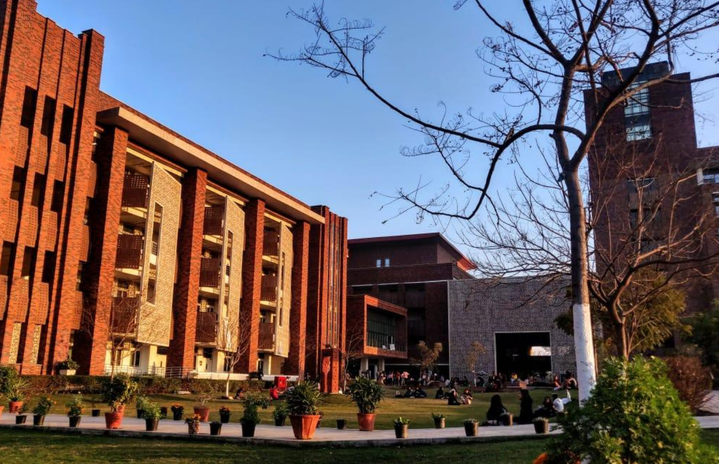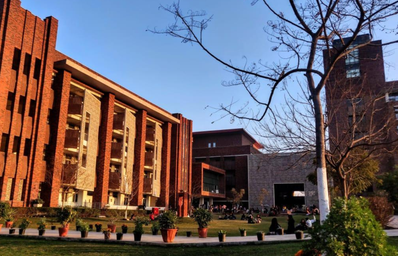Edited by: Shloka Sankar
I wake up in my dorm room, in the first Residence Hall built. As I sit on my bed I look at the red light in my glass bottle which was switched on all night. I push myself to the edge of my bed as it creaks like a wooden floor in a horror movie. I accidentally miss my slippers and feel the cold floor on my skin. It’s November, the late onset of winter and I am dreading the few eight AM classes I’m left with for this semester. I brush my teeth and wash my face with a gentle facial cleanser as was constantly mentioned by my favourite skincare influencers. It’s a Friday, my 8:30 class has been canceled, and my roommate is up early. We both grab our ID cards, and phones. 2 minutes, we’re at the gate heading to grab ourselves a chai and more. I am greeted by three pieces of my heart, Boop, Laadla, and Stockings. The three dogs live outside campus but are still very much a part of Ashoka. They’re not strays, they belong to this university as much as we do, they just don’t have a degree and placements to worry about. It’s just those wagging tales and a sweet little smile that makes all that academic rigmarole worth it. A small “good morning didi”, and “thank you didi” as I sign in and out transcends their job descriptions.
The tapri looks like a bunch of students, a blue wall, three dogs, cups of tea, and the smell of tobacco. It’s a pitstop to some, for others it’s a tiny little escape, filled with nicotine, tiny bits of caffeine, and a few other coping mechanisms. I can hear someone talking about Kant, and another parallel conversation is about the downsides of the morning-after pill, while some more gossip in hush-hush tones, it feels like a lot of what happens in social circles is rolled out here, at Saroj Aunty’s Tapri. A short walk from there and you end up at ASG, an interesting acronym for All Students Gathering. A fitting name for all students does gather here once in a while. Sumptuous, affordable, and quick, ASG is what you can call for a last-minute 10 pm food delivery for when you crave “outside food” but something that’s made at home. Less than a hundred meters away from ASG, you also have Thalassa, earlier known as Aroma Cafe, and still called that by most. You can see that place light up like a Christmas tree almost every other Thursday, filled with hundreds of Ashokans, dancing, singing, and whatnot.
After a Thursday night, as the Friday morning sun rises, the sense of the Ashokan resilience also awakens. The tapri now lights up again, with familiar faces, and unfamiliar news. The blue decaying wall becomes a mirror to reflect on what happened the night before, with the aroma of chai and freshly rolled tobacco, the Ashokan experience wraps itself up in a blanket once again. A chilly morning slowly turns into a sunny afternoon and later, an evening that reminds us that another night will soon be here, this one will simply be quieter than some others.
As a student who lives on campus, I’ve realized my journey is so much more than the four walls of my room, the walls of the classroom, and the boundaries of this campus. As a third year who has now gone beyond what boundaries tend to confine, I’ve come to realize that we are part of more than a university, it’s a microcosmic feeling that stretches beyond into spaces that exist beyond these boundaries. It’s a feeling in the nicotine and chai-struck air near Saroj Aunty’s Tapri, it’s something you can feel in ASG’s warm lighting, or the neon ones in Thalassa or Green Square on a Thursday.
When we usually think of space, we think of bricks, concrete, flooring, and anything that encompasses tangible beings and material objects. However, an immaterial feeling is often attached and projected onto these objects that puts them on a pedestal. I think that’s how spaces work too. Every room on this campus seems similar, with an orange headboard, a small table with a bright white tube light, and a small bulletin board next to a whiteboard. Our rooms are uniform, yet so different from one another. We all have lights mostly from the same tuck shop, however, they’re all so different for each room. While one table has an ashtray, the other has mangas, another table has a computer, and someone’s table is a shrine for Lana Del Rey. All these objects with a certain degree of materiality latched onto them, slowly distance towards an emotional and immaterial status that changes every space for everyone. All these spaces, which might look the same on the day of moving in for every batch and every pair of roommates, look different for everyone moving out. The lights that will be taken down, the posters that leave a residue on the walls, and a to-do list that is impossibly imprinted on the whiteboard leave an emotional imprint of their own in a once-alien space.
These rooms become repositories of our memories. Unfamiliar, uniform rooms that turn into familiar and unique sanctuaries. With a scent of our own, in an ambiance so comforting, these rooms become a haven of memories that we all share, cherish, and in some ways, also regret. Interestingly spaces that once felt so small, now feel cozy. The walls haven’t changed, and the sizes of the rooms haven’t either, it’s the feelings we’ve attached them to that have changed. Whether inside the campus or not, spaces have become such an integral part of how I’ve started to view life. The sense of emotional alchemy that envelopes the spaces we exist in transgresses a material tangibility that encompasses more than just bricks, concrete, and wood. Within these building blocks, there are conversations, arguments, tears, and laughs tied together by threads we’ve all woven together. It’s not just about spaces, it’s about stories that exist within them.


